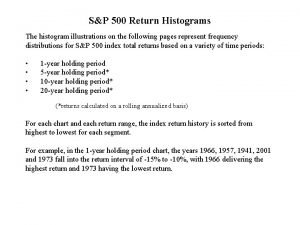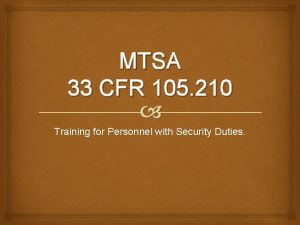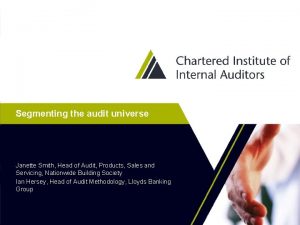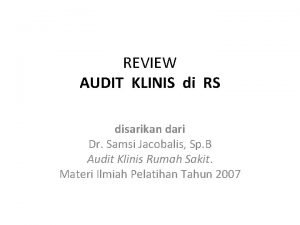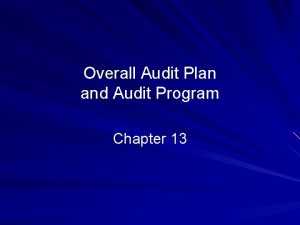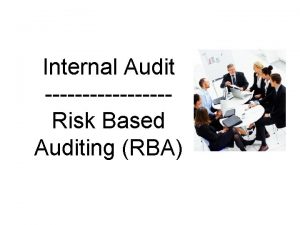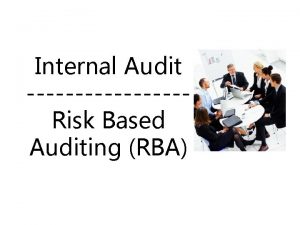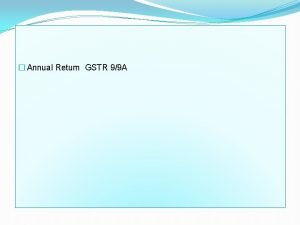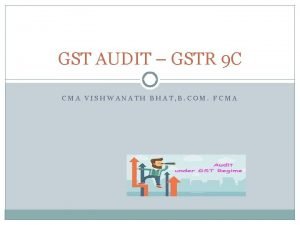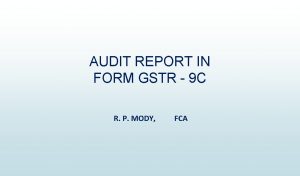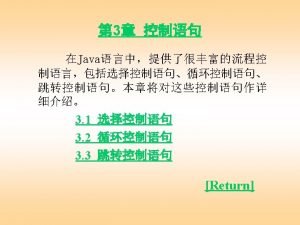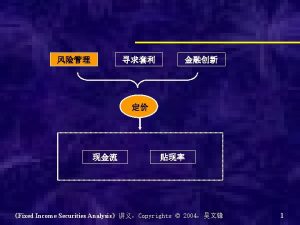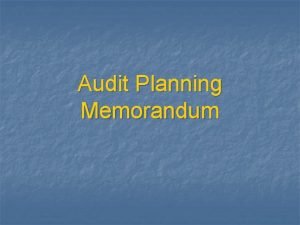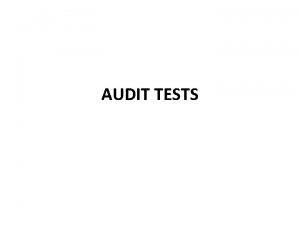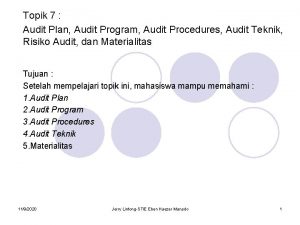GSTR 9 ANNUAL RETURN GSTR 9 C AUDIT












- Slides: 12

GSTR 9 ANNUAL RETURN GSTR 9 C AUDIT REPORT

GSTR 9 �GSTR-9 is an annual return format, which must be filed by all those who are registered under GST. Therefore, all regular taxpayers must file GSTR-9, while there’s a separate form for composition scheme taxpayers and e-commerce operators.

WHETHER THE THRESHOLD LIMIT FOR GSTR 9 C INCLUDES 2 CRORE OR NOT ?

�Taxpayers with annual turnover in excess of Rs 2 crore, must also file GSTR-9 C along with GSTR-9. �EXAMPLE 1 : MR X HAVING TURNOVER OF RS 2 CRORES THEN GSTR 9 C IS NOT APPLICABLE TO MR X �EXAMPLE 2: MR A HAVING TURNOVER OF RS 2. 5 CRORES THEN GSTR 9 C IS APPLICABLE TO MR A

PURPOSE OF GSTR 9 �GSTR-1 is filed by taxpayers to report supplies made by them and GSTR 3 B is used for payment of taxes. � While GSTR-9 may seem like a collation of these 2 returns, it isn’t as simple as that. � It requires taxpayers to carry out extensive reconciliation. This reconciliation between the returns filed by them for reporting supplies, paying taxes and those liation is filed by their vendors, and also with the books of accounts.

What are the details required to be filled in the GSTR-9? �GSTR-9 is divided into 6 parts and 19 sections. Each part asks for details that are easily available from your previously filed returns and books of accounts. �Broadly, this form asks for disclosure of annual sales, bifurcating it between the cases that are subject to tax and not subject to tax. �On the purchase side, the annual value of inward supplies and ITC availed thereon is to be revealed. �Furthermore, these purchases have to be classified as inputs, input services, and capital goods. Details of ITC that needs to be reversed due to ineligibility is to be entered.

Who should file GSTR-9, the annual return? All taxpayers/taxable persons registered under GST must file their GSTR 9. However, the following are NOT required to file GSTR 9: • Taxpayers opting composition scheme (They must file GSTR-9 A) • Casual Taxable Person • Input service distributors • Non-resident taxable persons Persons paying TDS under section 51 of CGST Act. NOTE: GSTR 9 A FOR COMPOSITION SCHEME HAS BEEN WAIVED OFF OFR FY 2017 -18 ANF 2018 -19

�No additional ITC claims can be made via GSTR-9, though additional tax payable found during reconciliation must be duly deposited with the government.

GSTR 9 C �GSTR-9 C is a reconciliation of GST as per GSTR-9 (the annual GST return) and GST as per audited financial accounts. �GSTR-9 must be filed for each GSTIN of a business. The main sources of populating GSTR-9 are the returns, GSTR-1 and GSTR-3 B.

FORMS FOR ANNUAL RETURN AND GST AUDIT �Type of taxpayer �Form to be filed �Whether or not applicable to GST Audit �A Regular taxpayer filing GSTR 1 and GSTR 3 B GSTR-9 �A Taxpayer under Composition Scheme GSTR-9 A �E-commerce operator GSTR-9 B �Applicable for GST Audit �Taxpayers whose turnover exceeds Rs. 2 crores in FY GSTR-9 C GSTR 9 C

Due date, late fees and penalty �The due date for filing GST annual return is 31 st December 2019. �The late fees for not filing the GSTR 9 within the due date, is Rs. 200 per day, per act. That means late fees of Rs. 100 under CGST and Rs. 100 under SGST will be applicable in case of delay. �Thus, the total liability is Rs. 200 per day of default. This is subject to a maximum of 0. 25% of the taxpayer’s turnover in the relevant state or union territory. However, there is no late fee on IGST yet.

THANK YOU BY: Jayesh D Ahuja ARTICLE ASSOCIATE
 Oep and aep catastrophe
Oep and aep catastrophe S&p 500 yearly returns
S&p 500 yearly returns 33 cfr 105
33 cfr 105 The word audit originated from the latin word
The word audit originated from the latin word Audit informasi klinis
Audit informasi klinis Perbedaan prosedur audit top-down dengan bottom-up
Perbedaan prosedur audit top-down dengan bottom-up Audit universe
Audit universe Beda audit medis dan audit klinis
Beda audit medis dan audit klinis Audit definition
Audit definition Overall audit plan
Overall audit plan Penyelesaian audit dan tanggung jawab pasca audit
Penyelesaian audit dan tanggung jawab pasca audit Perbedaan audit konvensional dengan audit berbasis risiko
Perbedaan audit konvensional dengan audit berbasis risiko Perbedaan audit konvensional dengan audit berbasis risiko
Perbedaan audit konvensional dengan audit berbasis risiko

